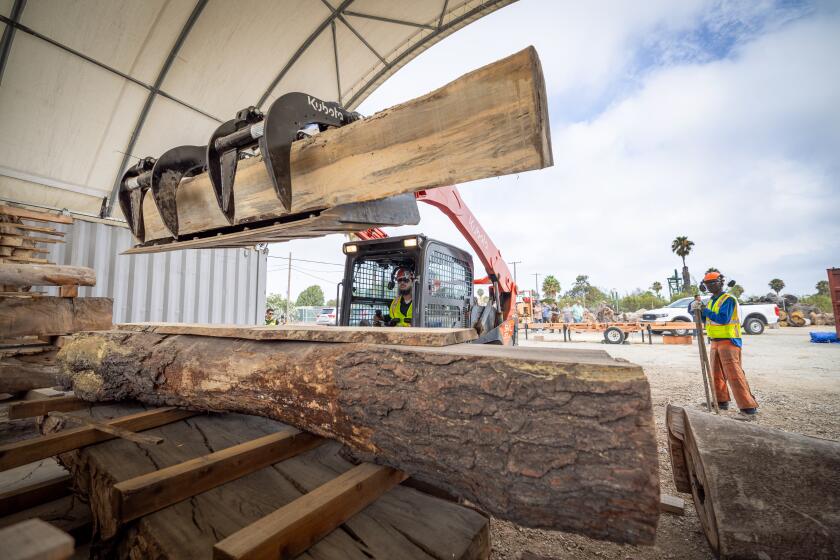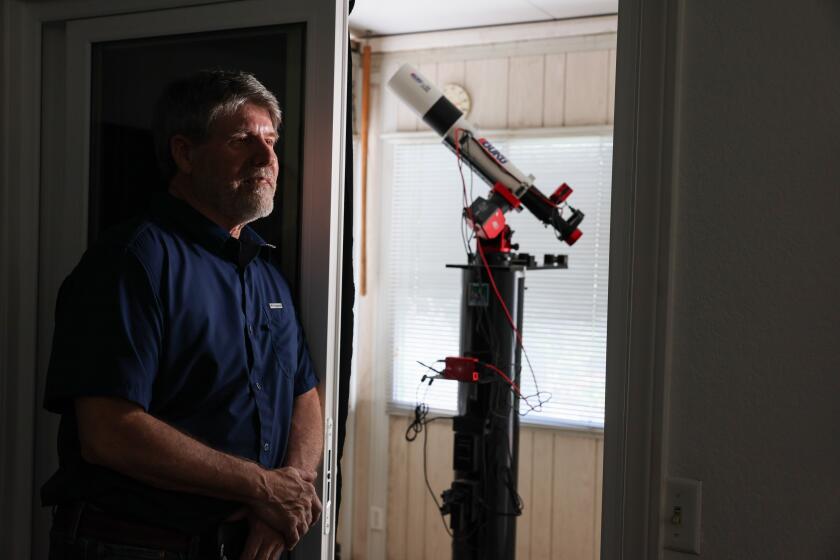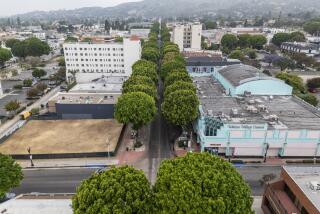
- Share via
An Inland Empire city has approved a development project 450 feet away from the third oldest known living organism in the world — a sprawling, shrub-like oak tree that is more than 13,000 years old.
While environmental groups and some city council members argued that scientists are only “guessing, at best” on the development’s potential impact on the tree, the Jurupa Valley City Council ultimately approved the project in a 3-2 vote.
Those in favor said they believed the project had taken adequate steps to protect the world’s oldest oak tree and that the development was unlikely to damage it.
The Jurupa Valley City Planning Commission has requested further study on a development that potentially threatens one of the oldest plants in the world.
An accompanying conservation plan would convey the 30-acre rocky outcrop that hosts the Quercus palmeri , or Palmer’s oak, to a Native tribe. The Kizh Nation, Gabrieleño Band of Mission Indians, has agreed to care for the land.
However, another Native tribe says the tree lives on its homeland instead, and that it has been blocked from participating in negotiations.
“This is a really hard decision but this is a responsible project that will bring benefits to all,” Councilmember Leslie Altamirano said after hours of emotional public testimony.
Aggressive and impactful reporting on climate change, the environment, health and science.
“The best part is that we have the opportunity to make precedent here and to give land back to the first peoples. So I want to make sure that, in my lifetime, I was able to do that,” she said before voting yes on the project. “So tonight, I’m going to stand with the Kizh Nation.”
The room broke out into applause.
“We understand the Jurupa Oak’s significance and have always been committed to its preservation,” said Brian Hardy, a representative for the developer, Richland Communities. The plan, which is supported by the Kizh Nation, “will provide protection that doesn’t exist now or in the previously approved project. We’re pleased that the City Council understood that and voted to approve the project,” he said in a prepared statement to The Times.
The project calls for the construction of almost 1,700 homes, and a light industrial park. A coalition of environmental groups is concerned that the pavement could create a heat island effect that would further stress the tree, which is already living in extreme conditions. They also worry that the development could deplete or contaminate the tree’s water source, or damage the tree’s root system.
In response, the city ordered additional root and heat studies in June. Environmental consultants concluded that heat effects would be minimal — hundreds of feet separated the tree and any parking lots, they said, and the developer planned to take measures to keep the pavement cool.
The consultants also said that the roots neither extended to the construction site nor did they reach any groundwater that could be affected by the development.
“I think we’ve got a pretty good picture of where the oak gets its water from and an estimation of how deep the roots go,” said Michael Tuma, the principal biologist at FirstCarbon Solutions, which has led environmental impact studies for the project. “There’s some other arguments that the opposition has come up with that are getting further and further away from reality and what’s backed by science.”
Biologists decided against mapping the tree’s root system, which would require invasive measures that could damage or kill the tree. Instead, they based their estimate on past studies of similar trees.
One Long Beach group is turning dead urban trees into usable lumber, while planting new saplings and providing work for the people society has left behind.
Without conclusive data, the coalition wants the city to preserve more land for the tree by cutting back on the light industrial buildings and business park planned in its vicinty.
“All of us, the coalition members that are concerned about the tree, we are not opposed to the development project,” said Tim Krantz, the conservation director of the Wildlands Conservancy. “We are only concerned about the areas immediately adjacent to, and uphill from the oak.”
A botanist from UC Riverside noticed the tree in the late 1990s. It struck him as a fish out of water: The oak was growing in a spot much hotter and drier than the species’ typical habitat.
He and a colleague hypothesized the tree might have first sprouted during the end of the last ice age, when the climate was much cooler. In a 2009 study, they determined the oak to be roughly 13,000 to 18,000 years old.
The tree has survived by producing genetically identical sprouts, or cloning, for millenia. This means the tree’s original trunk is long gone, but its genome persists. One of the paper’s authors compared the tree to the Ship of Theseus — a mythical vessel that has been entirely rebuilt with new parts.
Nonetheless, the tree has been a fixture of the landscape since mastodons and saber-toothed cats last roamed Southern California. For the Native tribes in the area, the oak played a central and sacred role in seasonal ceremonies and everyday life.
In a plan formulated by the developer, the city and the Kizh Nation, the plot of land surrounding the oak will be conveyed to the tribe before construction closest to the tree begins. The tribe will also be given $250,000 to conserve the land.
However, the Shiishongna Tongva Nation, Corona Band of Gabrielino Indians, says that the land is their homeland and that they’ve been excluded from deliberations with the city.
The oak is a “sacred ceremonial site for our villages in particular,” said Laura Jaime, tribal cultural anthropologist for the Shiishongna Tongva Nation. “We follow the Santa Ana river, so this goes back to time immemorial that we’ve been aware of this sacred ceremonial space.”
Since the land is now privately owned, they’ve been forced to hold ceremonies elsewhere — likely since the early 1800s, said Jaime.
With a rare star explosion expected any day now, astrophysicists are relying on a community of hobbyists with backyard telescopes to tell them when it erupts.
The city sent out a request for input on the project to a handful of Native tribes in 2015 and 2019. But, due to the strain of the pandemic, the Shiishongna Tongva Nation did not have the resources to participate, Jaime said.
Since then, the tribe has reached out “via email correspondences to the city, to the various departments, the planning commission, and the city council for that matter,” said Jaime. “We were subsequently ignored.”
Environmental groups, working closely with the Shiishongna Tongva Nation, will likely continue this battle in the courts.
Since the Kizh Nation identified the tree as a cultural resource, the city was legally required to keep information regarding the tree confidential, including its exact location. This has prevented outside biologists and experts from seeing key environmental studies, including how construction vibrations would impact the tree.
“It’s kind of the classic developer strategy of creating an us versus them situation,” said Krantz of the Wildlands Conservancy. “In this case, between the two tribes themselves.… It’s downright devious.”
Toward a more sustainable California
Get Boiling Point, our newsletter exploring climate change, energy and the environment, and become part of the conversation — and the solution.
You may occasionally receive promotional content from the Los Angeles Times.











